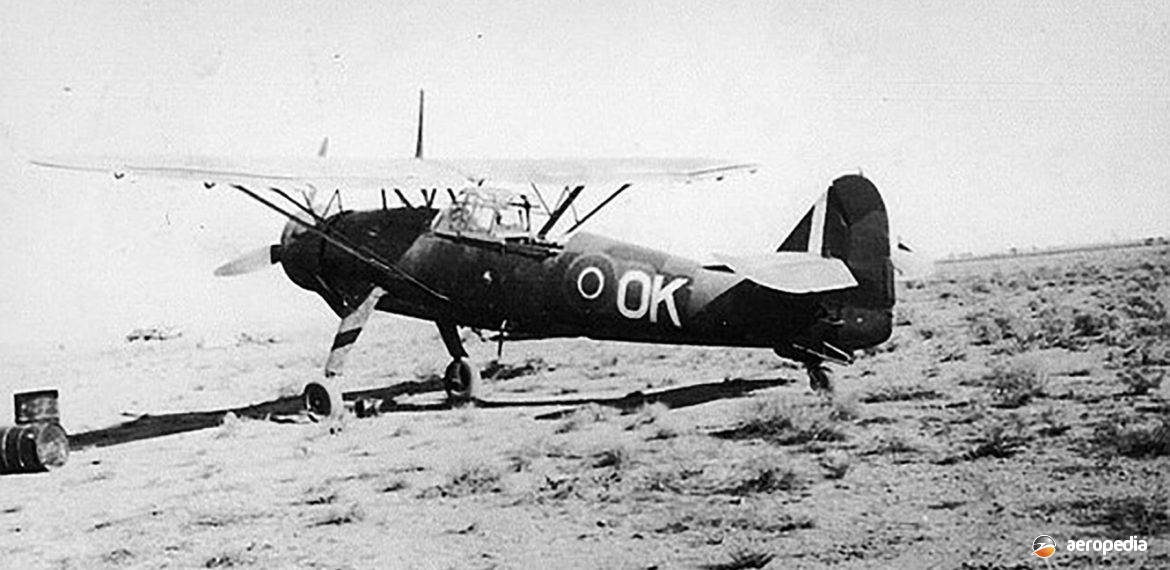Photograph:
Henschel Hs 126 captured by members of No 450 Squadron RAAF in the Middle East during World War II (Author’s collection)
Country of origin:
Germany
Description:
Two-seat tactical reconnaissance and Army co-operation monoplane
Power Plant:
(Hs 126B-1)
One 634 kw (850 hp) BMW Bramo Fafnir 323A-1 or Q-1 nine-cylinder air-cooled radial engine
Specifications:
- Wingspan: 14.5 m (47 ft 6¾ in)
- Length: 10.85 m (35 ft 7¾ in)
- Height: 3.75 m (12 ft 3½ in)
- Wing area: 22.3 m² (240.14 sq ft)
- Max speed at sea level: 311 km/h (193 mph)
- Max speed at 2,999 m (9,840 ft): 356 km/h (221 mph)
- Max speed at 5,998 m (19,680 ft): 335 km/h (208 mph)
- Climb to 610 m (2,000 ft): 3.5 mins
- Climb to 5,998 m (19,680 ft): 12.7 mins
- Service ceiling: 8,230 m (27,000 ft)
- Endurance: 2 hrs 15 mins
- Range with full fuel, no reserve, at 270 km/h (168 mph) at sea level: 579 km (360 miles)
- Range at 4,200 m (13,780 ft) at 335 km/h (208 mph): 719 km (447 miles)
- Empty weight: 2,032 kg (4,480 lb)
- Loaded weight: 3,270 kg (7,209 lb)
Armament:
One 7.9 mm (0.303 in) fixed forward-firing MG 17 machine gun in forward fuselage; one 7.9 mm (0.303 in) MG 15 machine gun on flexible mount in rear cockpit; ten 10 kg (22 lb) bombs in rear fuselage bay; or one 50 kg (110 lb) bomb on auxiliary rack on fuselage port side
History:
The Henschel Hs 126 was designed by Henschel Flugwerke AG at Schoenefeld (south of Berlin) as an Army co-operation aircraft and was eventually used as a multi-role tactical aircraft. It was developed in early 1936 from the Hs 122 and proved to be very successful, having very good STOL capability and being able to absorb punishment. Total production was 802 aircraft.
By June 1941 nearly all aircraft were operating in the Balkans, North Africa and the Eastern Front. A small number survived to 1944 but most survivors were used for towing gliders, and nocturnal harassing, being replaced in Luftwaffe units by the Focke Wulf Fw 189. The aircraft provided good view in all directions for the crew but could not survive in a hostile environment against enemy fighters.
The prototype was in fact a conversion of the fourth Hs 122A-0 airframe in 1936 and became the Hs 126 V1. At that time it was powered by a liquid-cooled Junkers Jumo 210 twelve cylinder engine pending availability of the Bramo Fafnir radial engine. Two further prototypes were built and these carried civil registrations, D-UJER for the Hs 126 V2 and D-OECY for the V3. These were powered by the Bramo radial engine.
The first batch of pre-production aircraft were the Hs 126A-0, followed by the Hs 126A-1, production taking place at Schoenefeld and Johannisthal, south-east of central Berlin. In 1939 16 Hs 126A-1s were ordered for the Royal Hellenic Air Force. By September 1939 275 were in Luftwaffe service. The Hs 126B-1 was later to take over the production line and this had the Bramo Fafnir 323 A-1, A-2, Q-1 or Q-2 engine with a two-speed supercharger and direct fuel injection.
During the invasion of Poland nine units were equipped with the type. At the time of the attack on France Hs 126s were used for photographic sorties over the Maginot Line. However, by early 1940 the type was suffering losses to Allied fighters on the Western Front and the Hs 126 soon became obsolescent. By April 1940 it was decided to place the Fw 189 in production to replace the Hs 126 and all survivors were transferred to the Russian Front, other than those in North Africa.
The Hs 126 was operated by Luftwaffe unit 2 [H] 14 in the North African campaign in 1941, this being the only unit to operate this type in that Theatre. Examples were left behind by crews as they were over-run by the Allied army units.
Members of No 450 Squadron Royal Australian Air Force (RAAF) in Libya in 1942 captured and restored at least one example to flying duties, this aircraft being flown by Squadron crews and given the Squadron’s Code OK. This aircraft was located by Sqdn Ldr D H Clarke DFC AFC on 12 November 1942, he being the only British pilot serving with the Australian unit. On returning from a strafing attack on a large concentration of enemy transports near Tobruk in Libya in a Curtiss P-40 Kittyhawk he located the Hs 126 (probably an Hs 126B-1) about 64 km (40 miles) west of the unit’s temporary landing ground and about 48 km (30 miles) south-east of Sollum in Egypt. On the following day, as the unit was moving to Gambut in eastern Libya, 50 km (31 miles) east of Tobruk, Clarke with four other pilots, a fitter and a rigger, left early, proceeding in a 762 kg (15 cwt – 1,680 lb) truck with supplies in another 3,048 kg (3 ton – 6,720 lb) truck. At that time locating abandoned Axis aircraft and flying them was a popular past-time and they came across five South African Air Force (SAAF) pilots in a jeep with the same idea.
The Hs 126 was located with Luftwaffe markings 5G + CK and the ground crew prepared it for flight. Some painting was done on the aircraft to indicate it was a RAAF aircraft and painted across the tailplane was ‘Tripoli or Bust’. The following day, the 14th, following ground running of the engine, the Hs 126 was flown to Gambut where, for a period, it became part of the No 450 Squadron fleet of captured aircraft. Eventually the aircraft was abandoned and it is assumed it was scrapped, along with other wartime wrecks.

